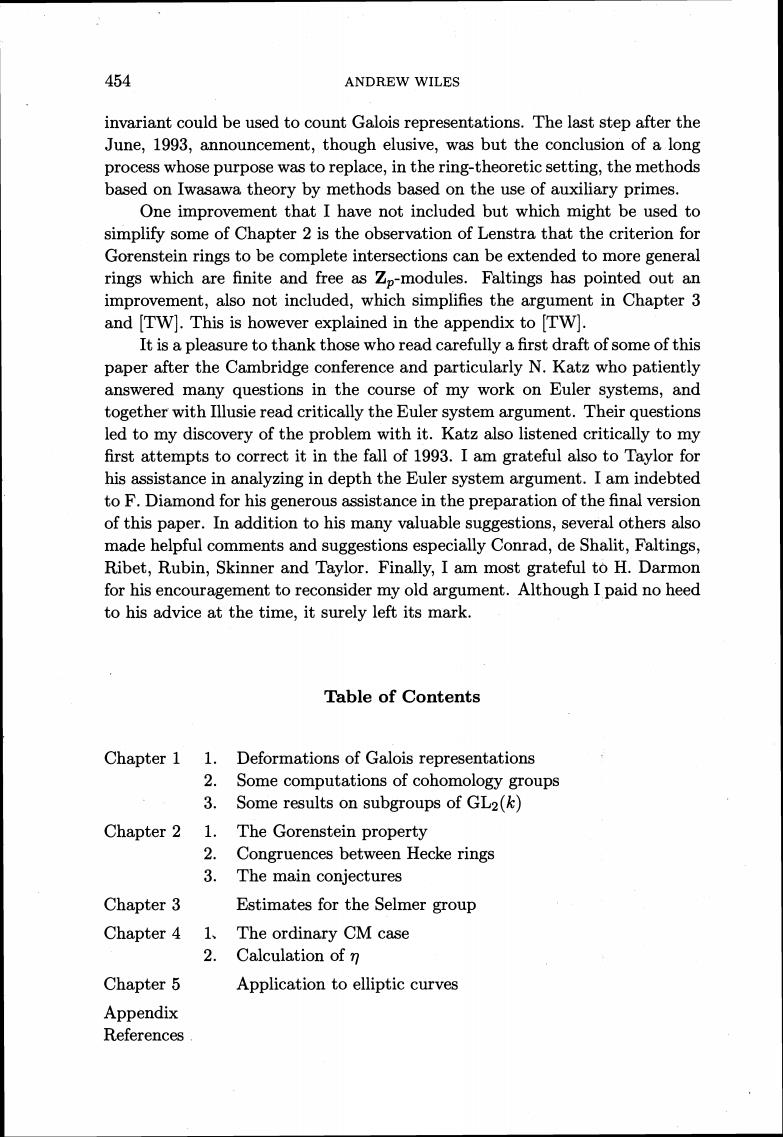正在加载图片...

454 ANDREW WILES invariant could be used to count Galois representations.The last step after the June.1993.announcement.though elusive.was but the conclusion of a long process whose purpose was to replace,in the ring-theoretic setting,the methods based on Iwasawa theory by methods based on the use of auxiliary prime One improvement that I have not included but which might be used to simplify some of Chapter 2 is the observation of Lenstra that the criterion for Gorenstein rings to be complete intersections can be extended to more general rings which are finite and free as Z-modules.Faltings has pointed out an improvement,also not included,which simplifies the argument in Chapter 3 and [TW].This is however explained in the appendix to TW). It is a pleasure to thank those who read carefully a first draft of some of this paper after the Cambridge conference and particularly N.Katz who patiently answered many questions in the course of my work on Euler systems,and together with Ilusie read critically the Euler system argument.Th eir questions edtomydiscovery of the problemwith it.Katzastedriticalltomy first attempts to correct it in the fall of 1993.I am grateful also to Taylor for his assistance in analyzing in depth the Euler system argument.I am indebted to F.Diamond for his generous assistance in the preparation of the final version of this paper.In addition to his many valuable suggestions,several others also made helpful comments and suggestions especially conrad.de shalit.faltings Ribet,Rubin,Skinner and Taylor.Finally,Iam most grateful toH.Darmon for his encouragement to reconsider my old argument.Although I paid no heed to his advice at the time,it surely left its mark. Table of Contents Chapter 1 1.Deformations of Galois representations 2 Some computations of cohomology groups 3. Some results on subgroups of GL2(k) Chapter 2 1. The Gorenstein property 2. Congruences between hecke rings 3. The main conjectures Chapter 3 Estimates for the Selmer group Chapter 4 1 The ordinary CM case 2. Calculation of n Chapter 5 Application to elliptic curves Appendix References 454 ANDREW WILES invariant could be used to count Galois representations. The last step after the June, 1993, announcement, though elusive, was but the conclusion of a long process whose purpose was to replace, in the ring-theoretic setting, the methods based on Iwasawa theory by methods based on the use of auxiliary primes. One improvement that I have not included but which might be used to simplify some of Chapter 2 is the observation of Lenstra that the criterion for Gorenstein rings to be complete intersections can be extended to more general rings which are finite and free as Zp-modules. Faltings has pointed out an improvement, also not included, which simplifies the argument in Chapter 3 and [TW]. This is however explained in the appendix to [TW]. It is a pleasure to thank those who read carefully a first draft of some of this paper after the Cambridge conference and particularly N. Katz who patiently answered many questions in the course of my work on Euler systems, and together with Illusie read critically the Euler system argument. Their questions led to my discovery of the problem with it. Katz also listened critically to my first attempts to correct it in the fall of 1993. I am grateful also to Taylor for his assistance in analyzing in depth the Euler system argument. I am indebted to F. Diamond for his generous assistance in the preparation of the final version of this paper. In addition to his many valuable suggestions, several others also made helpful comments and suggestions especially Conrad, de Shalit, Faltings, Ribet, Rubin, Skinner and Taylor. Finally, I am most grateful to H. Darmon for his encouragement to reconsider my old argument. Although I paid no heed to his advice at the time, it surely left its mark. Table of Contents Chapter 1 1. Deformations of Galois representations 2. Some computations of cohomology groups 3. Some results on subgroups of GL2(k) Chapter 2 1. The Gorenstein property 2. Congruences between Hecke rings 3. The main conjectures Chapter 3 Estimates for the Selmer group Chapter 4 1. The ordinary CM case 2. Calculation of 71 Chapter 5 Application to elliptic curves Appendix References